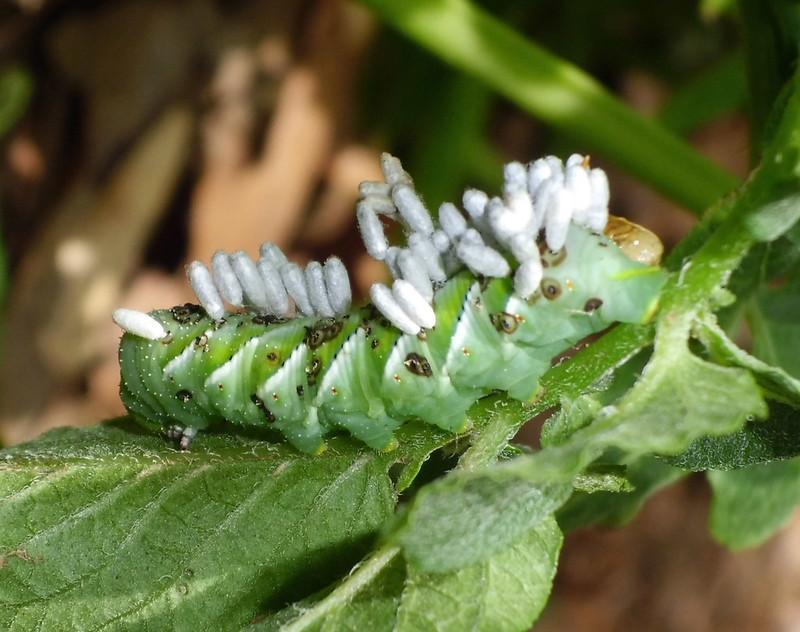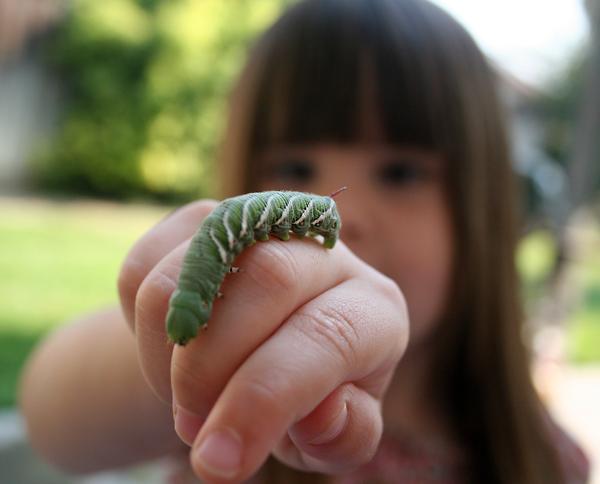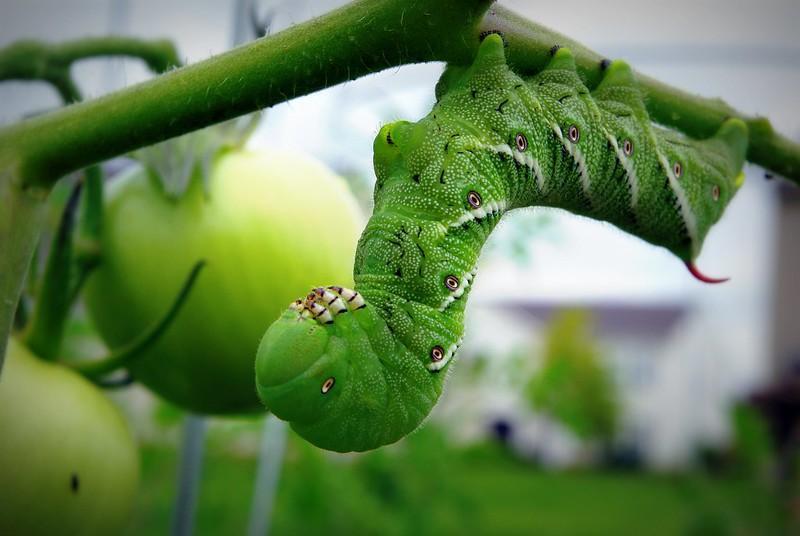It is Sunday morning. You wake up, and after your healthy breakfast, you decide to pick some tomatoes from your well-kept and looked-after home garden. You enter the garden and find gigantic green hornworms defoliating your tomato plants. Hmmm… not a good morning anymore! Read on and let’s discuss how to get rid of tomato worms.

The caterpillar, often known as the tomato hornworm, is a severe problem in tomato gardens.
No disease or nutritional deficiency can be worse than the devastation that these green hornworms can cause to tomato plants. In addition to tomatoes, the tomato worms will eat potatoes, peppers, and eggplants if they get a chance. However, there’s no need to panic! We got you all covered. Starting from “how to identify these monsters” to “keeping your tomato plants hornworm free,” We have it all here for you.
You can remove tomato worms by hand while wearing gloves from your plants if there are only a few of them and the infestation is small. However, if it sounds like too much effort, you can make a homemade spray of cayenne pepper, dish soap, and water to eliminate tomato worms from your plants. You can also spray insecticides on your tomato plants as a last resort. In some cases, the release of beneficial insects, like predatory wasps, can also aid with the control of these pesky tomato pests.
What Are Tomato Worms? I Identification Guide

Within its range, youngsters sometimes keep the tobacco hornworm as a pet.
Know thy enemy! As a gardener, you should always know about your enemy before coming across them on the battlefield. Memorize these two names, 1. Tomato hornworms 2. Tobacco hornworms. If you have ever grown tomatoes, there is a good chance that you have encountered these green caterpillar pests.
They are the two most common types of pests found in gardens across most of the United States and southern Canada. Both of them hold the Guinness Pest Record for destroying the tomato crop in the shortest amount of time. Being green in color, they can easily hide, blending in with the lush greenery of the tomato plants.
Big, thick, and green! These caterpillars have the potential to cause severe damage to tomato crops. After continuously feeding, they leave you patchy and chewed fruit and leaves.
Here are your cues for identifying hornworms:
- Their color, Green!
- They are fat and can be up to 5 inches in length.
- They have white and black spots with v-shaped marks running across their body.
- Finally, they are called hornworms for a reason! They have horns on their tails.
Related: What Is Eating Holes in Your Tomatoes? | Causes and Solutions
Tomato Worms | Life Cycle
Green hornworms are beautiful Sphinx moths in their larval stage. A fully grown Sphinx will lay eggs in the spring, and after some time, which is approximately a week, the eggs start to hatch, and voila, your enemy is here. Hornworms are the hungriest when they are born.
They start feeding immediately and leave behind nothing but a trail of black powder. This hunger game lasts for about one month, more than enough to eat your whole tomato garden, after which the young larva retreats and forms a cocoon to enter its pupal stage.
A new moth will emerge from the cocoon in about three weeks, and the cycle will start again.
Tomato Hornworm Vs. Tobacco Hornworm

The tobacco and tomato hornworms are the larvae of the Carolina sphinx moth and five-spotted hawk moth.
Although both species feed on plants commonly found in gardens, such as peppers, tomatoes, potatoes, and eggplants, they are different!
The following is a guide that will help you determine which caterpillar is which:
- Tomato hornworms have a black horn on the end of their tail, whereas tobacco hornworms have a bright red “horn.”
- Tomato hornworms do not have any black dots around the edges of their stripes, whereas tobacco hornworms have them.
- Unlike tomato hornworms, which have white markings in the shape of a V, tobacco hornworms have parallel white stripes.
Related: Vegetable Tomato Leaf Curl Virus: What Are the Causes & How to Fix Them?
How Do I Know If I Have Tomato Worms?
These caterpillars mix in perfectly with the plant foliage. You may, however, determine whether or not you have a tomato worm infestation in your garden by searching for the telltale indicators these pests leave behind.
So, you should prepare yourself for a daily patrol in your garden. Here is how to do it:
- Look for stems that are missing some of their leaves and leaves that are wilted and hanging down. Nearby, you might see white cocoons with their hornworm larvae.
- Sift through tomato leaves for any dark green or black droppings that may have been left behind by the larvae eating on the leaves. The next step is to examine the undersides of the leaves, where you will probably locate hornworms.
- Hornworms often begin their feeding process at the very top of the plant. Check these areas for gnaw marks or for leaves that have been removed.
How To Get Rid Of Tomato Worms?
Now that you have learned about tomato worms, where they are found, what they look like and how their life cycle works, we can move on towards discussing various approaches that you can take to get rid of them from your garden.
Your best course of action will be to take precautions to avoid their arrival in the first place. For example, it would be really helpful if you prevent your foe, the green hornworm, from entering your garden or, even better, from hatching in your garden.
This is the reason why we filled you in on the details of the hornworm life cycle. However, if it is too late for that, you can try controlling them with organic methods.
As for insecticides, they should only be used as a last resort when there is no other option.
Organic Control Methods For Tomato Worms
Once your garden is under attack by these green hornworms, you have to take action immediately. They have no mercy and will keep eating your plants day and night. Again there are several natural methods of removing them. Following are some suggestions
Hand-Picking
Wear your gardening gloves and get to work. Your plants need your help. You don’t have to worry about anything. Hornworms don’t bite. You can easily pick them and remove them from your plants. You can feed them to your chickens if you like. However, it may take some time to handpick them, depending on the number of plants and the size of your garden.
If you don’t have time, you can choose from the other recommended methods below.
Biological Measures To Stop Hornworms
If you are trying to eliminate tomato worms from your garden, birds and some other insects could be your allies. These insects are the good insects that will help you to kill the destructive insects. Your ally army can consist of birds, wasps, and ladybugs.
For instance, you can keep a birdhouse in your garden, and the birds will do the work of getting rid of the tomato worms for you. Green hornworms make delicious food for the birds.
Introducing wasps or ladybugs in your garden is another option. They both eat hornworms and can make your garden and tomato plants worm-free in a short time.
Tilling The Soil
After feeding, tomato worms will ultimately fall off and enter the soil in your garden, where they will remain buried and hidden all winter. Tilling the soil at the beginning of the farming season, that is, the beginning of the spring season, and at the end of the harvesting season, that is in the fall, is a good practice and a simple way to keep your tomato plants safe. Also, with tilling, you can change the position of the tomato plants. It will give some rest to the soil.
Homemade Spray For Tomato Worms
If none of those mentioned above methods seems to work against tomato worms, you can try making and using your non-toxic homemade spray. To do that, mix some soap or dishwashing liquid with water, and that’s it. It’s ready. You can spray it on the plant.
Make sure you also spray the underside of the leaves. That will stop moths from laying eggs on your plants in the first place: no eggs, no babies, no worries.
Bacillus Thuringiensis
Bacillus thuringiensis is a naturally occurring insecticide that can be applied to your plants to protect them from pests. However, one of its disadvantages is that for it to be effective, the tomato worm needs to consume it. But on the plus side, Bacillus thuringiensis is beneficial because it does not adversely affect other kinds of insects or animals.
Tulle Cloth To Stop Hornworms
The second method is to simply cover your plants with a tulle cloth simply. If you don’t like using soap water on your plants or think dishwashing liquid is also toxic, this method is for you. Tulle cloth will also prevent and keep moths away from your plants, and your plants will be safe.
Using Insecticides For Tomato Worms
Maybe your garden is very big, and you have many tomato plants. In that case, you may get tired of applying different methods, and still, you can’t eliminate the tomato worms. If this is the case, you can use insecticides as a last resort.
However, once again, we insist that you use the methods suggested above and leave using insecticides as your last and least favorite option.
Nevertheless, here are a few insecticides to consider for a tomato worm infestation:
Pyrethrins
Pyrethrins are a naturally occurring pesticide found in Chrysanthemum cinerariifolium, commonly known as chrysanthemum flowers. It is a combination of six poisonous compounds for use against pest insects.
Pyrethrins are frequently used to manage a variety of pests, including ants, fleas, flies, moths, and mosquitoes. Since this insecticide has a natural origin, it is comparatively safe to use.
Spinosad
The insecticide Spinosad is derived from chemical substances present in soil bacteria. It is made up of a combination of the molecules spinosyn A and spinosyn D. It is used to manage a range of pests, including ants, fruit flies, mosquitoes, spider mites, thrips, leafminers, etc.
All of the pesticides mentioned above are registered by the US Environmental Protection Agency (EPA) to be used in pesticides. But again, we suggest you try the prevention methods and natural remedies first and leave these options as your last resort.
Frequently Asked Questions (FAQs)
What do tomato worms turn into?
The caterpillar, often known as the tomato hornworm, can be a serious garden problem. Both tobacco and tomato hornworms develop into sizable, four to six-inch-wide moths with various hues, from brown and gold to pink and gray. These moths are known as the Carolina sphinx moth and the five-spotted hawk moth, respectively.
What naturally kills tomato worms?
Handpicking may be enough to eliminate tomato worms if you only have one tomato plant or a tiny population of them. Neem oil, on the other hand, is a fantastic all-natural, organic pesticide that is quite simple to use and works really well for large infestations.
How do you prevent tomato worms?
If you want to avoid tomato worms, there are several different strategies you can use. Keep ladybugs and green lacewings around, for example. They consume hornworm eggs or young hornworms and can keep their numbers in check. Similar to this, till the soil at the start and finish of each gardening season to eliminate overwintering larvae.
Will tomato plants recover from hornworms?
Even if the insect infestation has already begun, you can still save your tomato plants. You don’t have much time, but your plant will recover. Tomato worms are voracious eaters that can strip entire plants of their leaves in a matter of days. So, the faster you act, the better your chances of recovery.
How long do tomato worms live?
The average lifespan of a tomato worm is between two and three weeks. There are four phases in the life cycle of the tomato hornworm: the egg, the larva or caterpillar, the pupa, and the adult moth. Caterpillars hatch, begin feeding and reach full maturity in three to four weeks.
Where do tomato hornworms go during the day?
Hornworms are notoriously tricky to spot at first glance since their coloration allows them to mix in nicely with the green foliage of plants. However, since they typically stay hidden during the day behind leaves and come out to feed just before nightfall, this generally is the best time of day to look for them.
Do tomato hornworms bite?
Although these worms may have a frightening and brutal appearance, they do not possess stingers, and they do not bite. They are very safe for people to handle, and you can even pick one up in your hand. In fact, some people keep these moth larvae as pets.
Sources For Further Reading
Tomato hornworm, Manduca quinquemaculata (Haworth). (2022). Retrieved 17 August 2022, from https://entnemdept.ufl.edu/creatures/field/hornworm.htm
Tomato hornworm, Manduca quinquemaculata (Haworth). (2022). Retrieved 17 August 2022, from https://entnemdept.ufl.edu/creatures/field/hornworm.htm
Tomato Hornworm. (2022). Retrieved 17 August 2022, from https://hortnews.extension.iastate.edu/tomato-hornworm
Tomato and Tobacco Hornworms. Retrieved 17 August 2022, from https://extension.usu.edu/pests/research/tomato-tobacco-hornworms
Editor’s Recommendations
How To Identify, Control, And Prevent Red Pumpkin Beetles In Your Garden?
What Are The Little White Things in Plant Soil 8 Ways to Get Rid of Pests?
5 Foods in Your Home that Attract Pests Plus How to Repel Them!







